The Radeon HD 4850 & 4870: AMD Wins at $199 and $299
by Anand Lal Shimpi & Derek Wilson on June 25, 2008 12:00 AM EST- Posted in
- GPUs
Building a RV770
We did this with NVIDIA's GT200 and it seemed to work out well, so let's start at the most basic level with AMD's RV770. Meet the Stream Processing Unit:
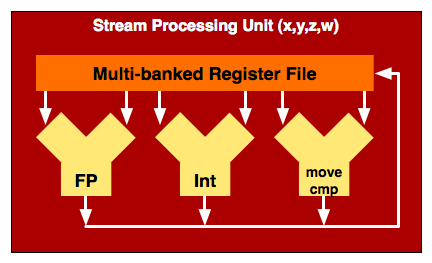
AMD's Stream Processing Unit is very similar to NVIDIA's SP in G80/G92/GT200, so similar in fact that I drew them the same way. Keep in mind that the actual inner workings of one of these units is far more complex than three ALUs but to keep things simple and consistent that's how I drew it (the actual hardware is a fused FP MUL + ADD unit, for those who care). AMD has four of these stream processing units in a processor block and they are called x, y, z or w units.
There's a fifth unit called a t-unit (the t stands for transcendental, meaning the type of operations it is capable of processing):

The t-unit can do everything a x,y,z or w-unit can do, but it also can do transcendental operations (represented by the SFU block in the diagram above). NVIDIA has the same functionality, it simply chooses to expose it in a different way (which we'll get to shortly). AMD considers each one of these units (x,y,z,w and t) a processing unit, and the RV770 has 800 of them (the RV670 had 320).
AMD pairs four of these stream processing units (x,y,z and w) with a t-unit and puts them together as a block, which I have decided to call a Streaming Processor (SP):

The area in red is actually the SP, but unlike one of NVIDIA's SPs, one of AMD's can handle up to five instructions at the same time. The only restriction here is that all five units have to be working on the same thread.
AMD then groups 16 of these SPs into something they like to call a SIMD core (AMD has less confusing, but far worse names for its architectural elements than NVIDIA):
|
AMD's SIMD Core
|
NVIDIA's SM
|
 |
 |
A SIMD core is very similar to NVIDIA's SM with a couple of exceptions:
1) There are more SPs in AMD's SIMD Core (16 vs 8)
2) The SPs are wider and can process, at peak, 5x the number of instructions as NVIDIA's SPs
3) The Instruction and Constant caches are not included in the SIMD core, AMD places them further up the ladder.
4) AMD pairs its texture units and texture cache with its SPs at the SIMD core level, while NVIDIA does it further up the ladder.
5) See the two SFUs in NVIDIA's SM? While NVIDIA has two very fast Special Function Units in its SM, AMD equips each SP with its own SFU. It's unclear which approach is actually faster given that we don't know the instruction latency or throughput of either SFU.
Note that at this point, the RV770 is really no different than the RV670 (the GPU used in the Radeon HD 3870). The next step is where AMD and NVIDIA really diverge; while NVIDIA's GT200 takes three SMs and groups them into a Texture/Processing Cluster (TPC) and then arranging 10 TPCs on its chip, AMD simply combines 10 SIMD cores:
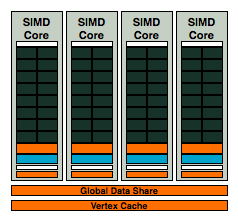
AMD's RV670
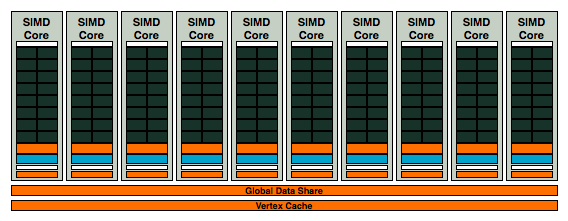
10 SIMD cores at your disposal in AMD's RV770, this is how AMD goes from competitive, to downright threatening
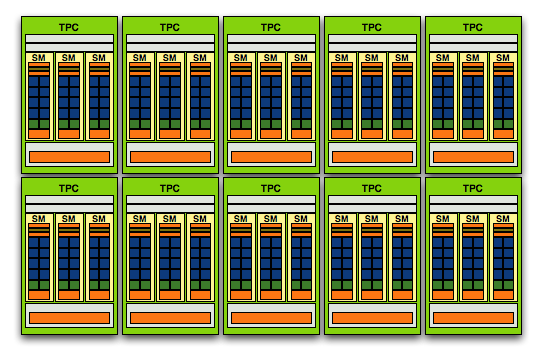
NVIDIA's GT200 Streaming Processor Array (SPA), it has fewer execution resources but more encapsulation around them, the focus here is on thread management
With 10 SIMD cores the RV770, it has 2.5x the number of execution units as a RV670. It even has more theoretical processing power than NVIDIA's GT200. If you just look at the number of concurrent instructions that can be processed on RV770 vs. GT200, the RV770's 800 execution units to GT200's 240 (+ 60 SFUs) is in a completely different league.
| NVIDIA GT200 | AMD RV770 | AMD RV670 | |
| SP Issue Width | 1-way | 5-way | 5-way |
| # of SPs | 240 | 160 | 64 |
| Worst Case Dependent Instruction Throughput | 240 | 160 | 64 |
| Maximum Scalar Instruction Throughput | 480* | 800 | 320 |
We'll be talking about efficiency and resource utilization in the coming pages, but immediately you'll notice that the RV770 (like the RV670 and R600 that came before it) has the potential to be slower than NVIDIA's architectures or significantly faster, depending entirely on how instruction or thread heavy the workload is. NVIDIA's architecture prefers tons of simple threads (one thread per SP) while AMD's architecture wants instruction heavy threads (since it can work on five instructions from a single thread at once).
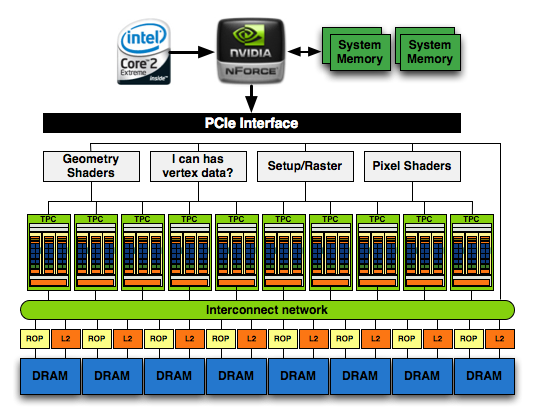
NVIDIA's GeForce GTX 280
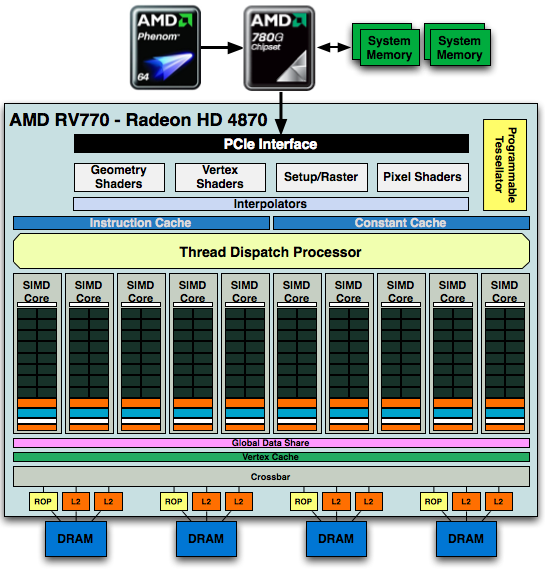
AMD's Radeon HD 4870
The full GPU is pretty impressive:
1) See the Instruction and Constant Caches up top? NVIDIA includes them in each SM while AMD seems to include them outside of the SIMD core clusters.
2) The RV770 only has four 64-bit memory controllers compared to the eight in GT200
3) The Programmable Tessellator is left over from the Xbox 360's GPU (and R600/RV670), unfortunately it is unused by most developers as there is no DirectX support for it yet.
4) AMD has dedicated hardware attribute interpolators, something NVIDIA's hardware shares with its special function units (SFUs).
Other than the differences we mentioned above, AMD's architecture is similar in vain to NVIDIA's, there are just a handful of design choices that set the two apart. Just like NVIDIA took its G80/G92 architecture and made it larger, AMD did the same with RV770 - it took RV670 and more than doubled its execution resources.
AMD took a bigger leap with RV770 from RV670 than NVIDIA did from G80/G92 to GT200, but it makes sense given that AMD had to be more competitive than it even was in the last generation.










215 Comments
View All Comments
shadowteam - Wednesday, June 25, 2008 - link
Did you know these chips can do up to 125C? 90C is so common for ATI cards, I haven't had one since 2005 that didn't blow me hair dry. Your NV card was just a bad chip I suppose. Why do you think NV or ATI would spend a billion dollars in research work, then let its product burn away due to some crappy cooling? They won't give you more cooling than you actually need. It's the same very cards that go to places like Abu-Dhabi, where room temps. easily hit 50C+.soloman02 - Wednesday, June 25, 2008 - link
Sorry, but no human would survive a temp of 50C.http://en.wikipedia.org/wiki/Thermoregulation#Hot">http://en.wikipedia.org/wiki/Thermoregulation#Hot
In fact the highest temp a human has survived was recorded by the Guinness book of world records as: 46.5C (115.7F). Keep in mind that was the internal temp of the guy. The temp on that day was 32.2C (90F).
http://www.powells.com/biblio?show=0553587129&...">http://www.powells.com/biblio?show=0553587129&...
http://www.time.com/time/magazine/article/0,9171,9...">http://www.time.com/time/magazine/article/0,9171,9...
If it is 50C in those rooms, the people inside are dead or dying.
The cards are probably fine. All it takes is to search google to back up your figures (or to disprove them like I just did).
shadowteam - Wednesday, June 25, 2008 - link
You're just a dumb pissed off loser. There's a big difference in internal human temperature to its surroundings. In places like Sahara, temperatures routinely hit 45C, and max out @ 55C. But does that mean people living there just die? No they don't, because they drink a lot of water, which helps their bodies get rid of excess heat so to keep their internals at normal temperature (32C). You didn't have this knowledge to share so you decided to Google it instead, and make fool out of yourself. Here, let me break it down for you,You said: "Keep in mind that was the internal temp of the guy"
Exactly, the guy was sick, and when you're sick, your body temperature rises, in which case 46C is the limit of survival. I suggest you take Bio-chemistry in college to learn more about human body, which is another 4 years before you finish school.
Ilmarin - Wednesday, June 25, 2008 - link
I'm not talking about chips failing altogether... just stability issues, similar to what you experience from over-zealous overclocking. Lots of people have encountered artifacting/crashes with stock-cooled cards over the years. If these are just 'bad chips' that are experiencing stability issues at high temps, then there are a lot of them getting through quality control. Of course NV and ATI do enough to make most people happy... but many of us have good reason to be nervous about temperature. I think they can and should do better. Dual slot exhaust coolers should be mandatory for the enthusiast/performance cards, with full fan control capability. Often it's up to the partners to get that right, and often it doesn't happen for at least a couple of months.shadowteam - Wednesday, June 25, 2008 - link
I think it's more profitable for board partners to just roll out a stock card rather than go through the trouble of investing time/money into performance cooling. What I've seen thus far, and it's quite apparent, that newer companies tend to go exotic cooling to get themselves heard. Once they're in the game, it's back to stock cooling. For example, Palit and ECS came up with nice coolers for its 9600s. Remember Leadtek from past years? They don't even do custom coolers any more. ASUS, Powercolor, Gigabyte, Sapphire etc just find it easier to throw in a 3rd party cooler from ZM, TT TR, and call it a day.DerekWilson - Wednesday, June 25, 2008 - link
you know we actually received an updated bios for a certain vendors 4850 that speeds the fan up a bit and should reduce heat ...i suspect a lot of vendors will start adjusting their fan tables actually ...
shadowteam - Wednesday, June 25, 2008 - link
I think this reply was meant for the guy right above me. I'm all for stock cooling :).ImmortalZ - Wednesday, June 25, 2008 - link
"Quake Wars once again shows the 4870 outperforming the GTX 280, but this time it offers essentially the same performance as the GTX 280 - but at half the price. "You mean the 260 in the first instance?
No text in The Witcher page. I assume this is intentional.
Also, I've heard on the web that the 48xx series has dual-link only on one of it's DVI ports. Is this true?
Oh and another thing - why is the post comment page titled "Untitled Page"? :P
rahat5810 - Wednesday, June 25, 2008 - link
Nice cards and nice article. But I would like to point out that there are some mistakes in the article, nothing fatal though. Like, not mentioning 4870 in the list of cards, writing 280 instead of 260, clicking on the picture to enlarge not working for some of the figures.feelingshorter - Wednesday, June 25, 2008 - link
AMD almost has a perfect card but the fact that the 4870 idles at 46.1 more watts than the 260 means the card will heat up people's room. At load, the difference of 16.1 watts more for the 4870 is forgivable.If its possible to overclock a card using software (without going into BIOS screen), then why isn't it possible to underclock a card also using software when the card's full potential isn't being used? I'd really be interested in knowing the answer, or maybe someone just hasn't asked the question?
I hardly care about Crysis, its more a matter of will it run Starcraft II with 600 units on the map without overheating. Why doesn't anandtech also test how hot the 4870 runs? Although the 4850 numbers aren't pretty at all, the 4870 is a dual slot cooler and might give better numbers right? I only want to know because, like a lot of readers, i have doubts as to whether a card like the 4850 can run super hot and not die within 1+ years of hardcore gaming.